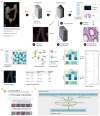This is a preprint.
Human BioMolecular Atlas Program (HuBMAP): 3D Human Reference Atlas Construction and Usage
- PMID: 38826261
- PMCID: PMC11142047
- DOI: 10.1101/2024.03.27.587041
Human BioMolecular Atlas Program (HuBMAP): 3D Human Reference Atlas Construction and Usage
Update in
-
Human BioMolecular Atlas Program (HuBMAP): 3D Human Reference Atlas construction and usage.Nat Methods. 2025 Apr;22(4):845-860. doi: 10.1038/s41592-024-02563-5. Epub 2025 Mar 13. Nat Methods. 2025. PMID: 40082611 Free PMC article.
Abstract
The Human BioMolecular Atlas Program (HuBMAP) aims to construct a reference 3D structural, cellular, and molecular atlas of the healthy adult human body. The HuBMAP Data Portal (https://portal.hubmapconsortium.org) serves experimental datasets and supports data processing, search, filtering, and visualization. The Human Reference Atlas (HRA) Portal (https://humanatlas.io) provides open access to atlas data, code, procedures, and instructional materials. Experts from more than 20 consortia are collaborating to construct the HRA's Common Coordinate Framework (CCF), knowledge graphs, and tools that describe the multiscale structure of the human body (from organs and tissues down to cells, genes, and biomarkers) and to use the HRA to understand changes that occur at each of these levels with aging, disease, and other perturbations. The 6th release of the HRA v2.0 covers 36 organs with 4,499 unique anatomical structures, 1,195 cell types, and 2,089 biomarkers (e.g., genes, proteins, lipids) linked to ontologies and 2D/3D reference objects. New experimental data can be mapped into the HRA using (1) three cell type annotation tools (e.g., Azimuth) or (2) validated antibody panels (OMAPs), or (3) by registering tissue data spatially. This paper describes the HRA user stories, terminology, data formats, ontology validation, unified analysis workflows, user interfaces, instructional materials, application programming interface (APIs), flexible hybrid cloud infrastructure, and previews atlas usage applications.
Figures



Similar articles
-
Human BioMolecular Atlas Program (HuBMAP): 3D Human Reference Atlas construction and usage.Nat Methods. 2025 Apr;22(4):845-860. doi: 10.1038/s41592-024-02563-5. Epub 2025 Mar 13. Nat Methods. 2025. PMID: 40082611 Free PMC article.
-
Tissue registration and exploration user interfaces in support of a human reference atlas.Commun Biol. 2022 Dec 13;5(1):1369. doi: 10.1038/s42003-022-03644-x. Commun Biol. 2022. PMID: 36513738 Free PMC article.
-
Construction, Deployment, and Usage of the Human Reference Atlas Knowledge Graph.Sci Data. 2025 Jul 1;12(1):1100. doi: 10.1038/s41597-025-05183-6. Sci Data. 2025. PMID: 40592888 Free PMC article.
-
Education, incentive, and engineering-based interventions to promote the use of seat belts.Cochrane Database Syst Rev. 2024 Jan 10;1(1):CD011218. doi: 10.1002/14651858.CD011218.pub2. Cochrane Database Syst Rev. 2024. PMID: 38197528 Free PMC article.
-
Comparison of self-administered survey questionnaire responses collected using mobile apps versus other methods.Cochrane Database Syst Rev. 2015 Jul 27;2015(7):MR000042. doi: 10.1002/14651858.MR000042.pub2. Cochrane Database Syst Rev. 2015. PMID: 26212714 Free PMC article.
References
Publication types
Associated data
Grants and funding
- OT2 OD033760/OD/NIH HHS/United States
- U54 HL165443/HL/NHLBI NIH HHS/United States
- OT2 OD033759/OD/NIH HHS/United States
- OT2 OD026671/OD/NIH HHS/United States
- OT2 OD026682/OD/NIH HHS/United States
- OT2 OD033761/OD/NIH HHS/United States
- OT2 OD033756/OD/NIH HHS/United States
- U54 AG075932/AG/NIA NIH HHS/United States
- OT2 OD026673/OD/NIH HHS/United States
- U24 CA268108/CA/NCI NIH HHS/United States
- U24 DK114886/DK/NIDDK NIH HHS/United States
- U01 HL148861/HL/NHLBI NIH HHS/United States
- OT2 OD026675/OD/NIH HHS/United States
- R03 OD036499/OD/NIH HHS/United States
- U24 DK135157/DK/NIDDK NIH HHS/United States
- P30 ES001247/ES/NIEHS NIH HHS/United States
- U54 AG075936/AG/NIA NIH HHS/United States
- RM1 HG011014/HG/NHGRI NIH HHS/United States
- U2C DK114886/DK/NIDDK NIH HHS/United States
LinkOut - more resources
Full Text Sources
Research Materials
Miscellaneous
